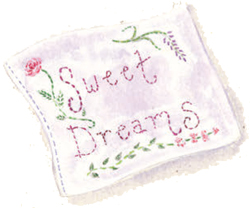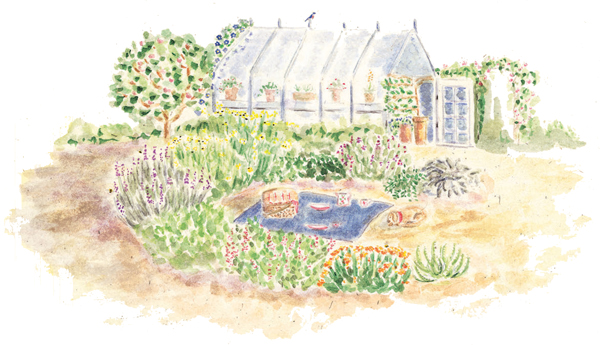
Seeds and leaves, roots and flowers, ancient plants with healing powers.
Step inside the fragrant arch of your horseshoe-shaped herb garden and travel back in time. Long before there were doctors and pharmacies, hospitals and nurses, people turned to plants for their medicinal needs. Many of these green medicines are still used today.
Plant a garden of ancient herbs and learn how early healers used them to cure sicknesses and aid in emergencies. At harvest time, you’ll be able to fill your own medicine chest with homegrown remedies.
Slit open an Aloe leaf and squeeze the clear gel on your shin. It feels cool and soothing. Use it whenever you have a minor burn or skin irritation.
Stuff a pillow with lavender to ensure sweet, colorful dreams, and make your own bandages with woolly lamb’s ear leaves.
You’ll be able to concoct a lemon balm wash for cold sores, and a healing throat gargle from sage leaves steeped in vinegar.
The petals of golden Calendula will surprise you with their ability to cleanse wounds and heal chapped skin, and a cup of catnip tea may become your favorite sleepy-time drink.

Select a flat 8-by-8-foot area that gets at least six hours of sun daily. Stand in the center of your plot at noon; the shadow you cast will point north. Outline a horseshoe shape, 6 feet wide and 8 feet long with planting beds 18 inches wide. Make sure the horseshoe opening faces south.
Prepare the bed for planting (see Preparing the Soil). Top your bed with a 2-inch layer of aged manure, and work it into the soil. Rake the plot smooth. Spread shredded bark in the horseshoe opening to keep down weeds and provide a dry, soft sitting area.
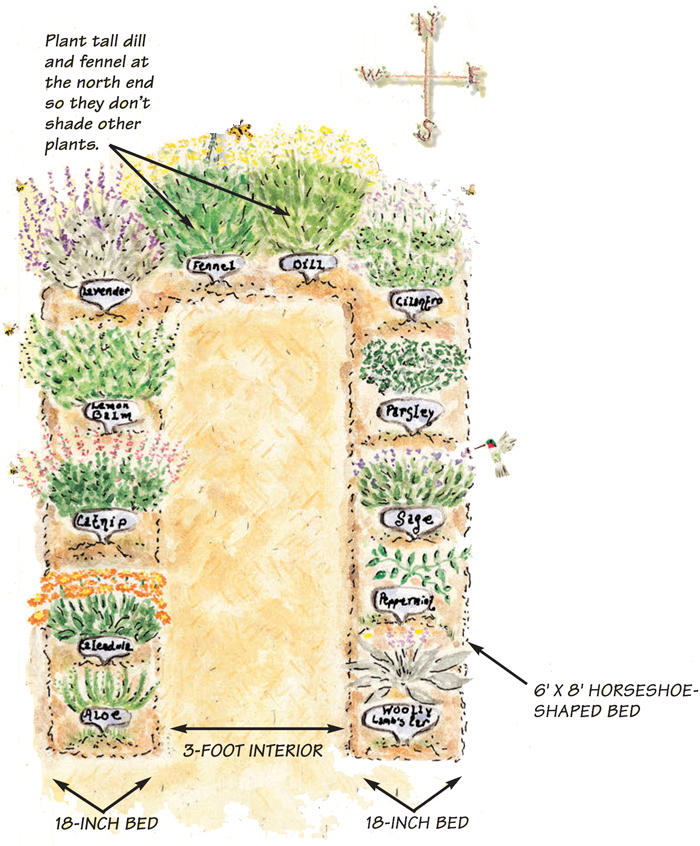
Begin planting when temperatures remain above 55°F and after all danger of frost has passed. Start planting 1 foot from one end of the horseshoe, and work your way around to the other end. The holes should be twice the width and depth of the seedlings’ root balls. Pretreat the holes with vitamin B1 (see Planting Seedlings).
Plant the seedlings, except cilantro, 18 inches apart. Place cilantro seedlings 6 inches apart. Put the tallest herbs, fennel and dill, on the north side.
Poke your finger into the soil each day to see if it is moist. If it feels dry, water deeply. Feed your herbs once a month with a full-strength blend of liquid kelp and fish emulsion.
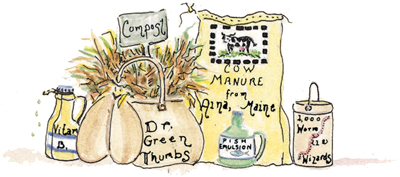

Your herbs will awaken all your senses. Touch, taste, smell, look, and listen. Get to know the plants and learn some of their powerful healing secrets.
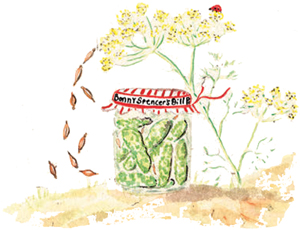
1. For thousands of years people used dill to quiet upset stomachs and heartburn. Taste the foliage flower buds, and seeds.
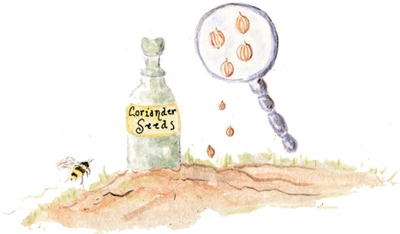
2. Search through the blooms of the cilantro plant for the small, round seedpods called coriander. Snack on them for a breath-freshening flavor jolt.
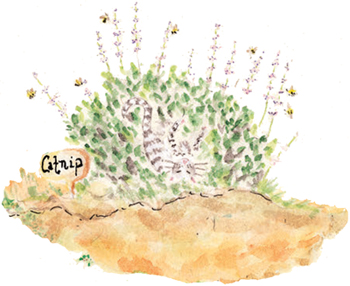
3. Watch your cat frolic and roll in the catnip. Pick some leaves and stuff them into an old sock for an indoor toy.
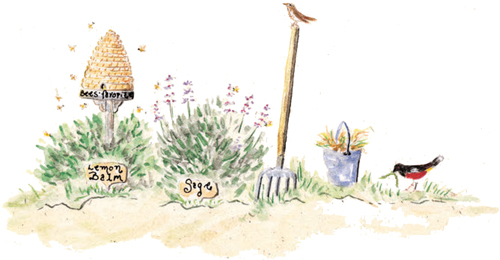
4. Crush a lemon balm leaf in your hand, and smell its sharp odor and taste its flavor. Beekeepers surround their hives with this herb because it attracts bees.

5. Sit in the middle of the horseshoe, close your eyes, and tune in to the zipping sounds of hummingbird wings, the buzz of bumblebees, and the musical calls of visiting birds.
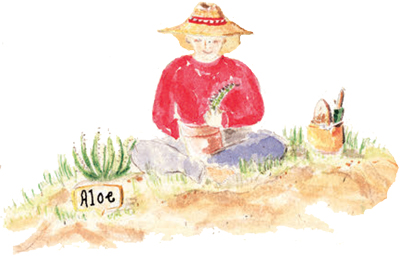
6. Pick an Aloe leaf slit it open with your fingernail, and spread the cool gel onto your skin.
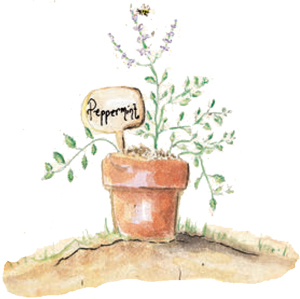
7. Rub pungent peppermint leaves on your skin to discourage bugs or weave a bug-chaser crown out of its long, supple stems.
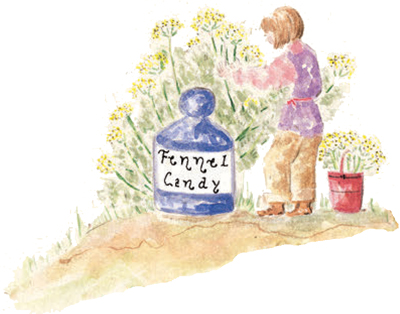
8. If you like the taste of licorice, you won’t be able to pass your fennel without nibbling. Fennel is called the weight-watcher’s herb because it satisfies an appetite.
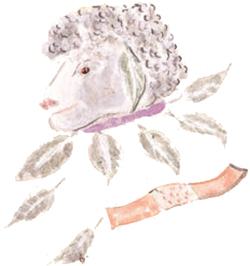
9. Rub the fuzzy, gray woolly lamb’s ears, and you’ll understand how this herb earned its name. Healers used this soft plant as a bandage.
Nothing smells better than harvest day in your herb garden. Whenever you brush against a plant or cut a stem, sweet and spicy fragrances surround you.
Harvest your herbs on a dry day. Tie them in small, hand-size bunches, and hang them in a warm, dark place to dry.
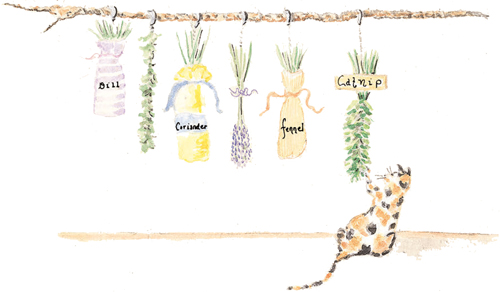

Cut stems of fennel, dill, and cilantro. Separate the plants into bunches, and tie them with string. Stick the bunches into small brown paper bags, seed heads first, and tie the bags-closed. Hang in a dark, warm area. When thoroughly dry, shake the seeds from the heads and bottle them. Save some fennel and dill seeds for a dream pillow, here.
For an upset stomach, put a few coriander, dill, or fennel seeds in a tea ball and drop into a pot of freshly brewed herb tea. (Remove the tea ball or strain before drinking.)
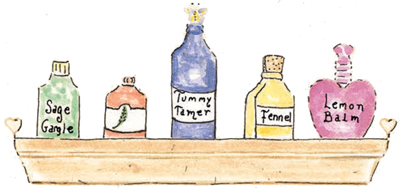

Strip dried peppermint leaves from their stems, pack them into a clean tin, and cover with an airtight lid. Store in a cool, dark cupboard.
Herbalists use the healing, anesthetic menthol of peppermint tea to soothe upset stomachs and indigestion. Scoop 2 to 3 teaspoons per cup into a tea ball, place into a teapot, and add boiling water. Steep for 8 minutes, cool, then sip slowly for gentle relief.
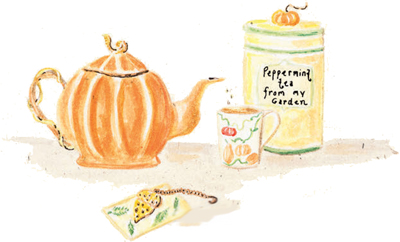

Sage leaves are filled with astringent and antiseptic tannins that comfort sore throats. Pack a widemouthed jar with whole dried or fresh sage leaves. Cover the sage leaves completely with apple cider vinegar and cap tightly. Store in a cool, dark place, and shake daily. After two weeks, pour the sage-vinegar mixture through a strainer and rebottle the liquid. Put it in your medicine cabinet and use as a gargle for sore throats.
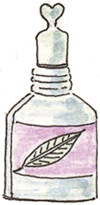

Strip dried lemon balm leaves from their stems, and fill a clean glass or tin container. Cap tightly and store in your medicine chest to make an antiviral wash for cold sores. Put 2 to 4 teaspoons of dried herbs in a container, and add 1 cup of boiling water. Steep for 10 minutes, strain, and let cool. Apply the cooled mixture to, cold sores with a sterile cotton ball several times a day.

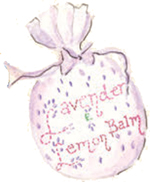
Bath bags are simple to make and can be washed and reused. With pinking shears, cut a piece of fabric into an 8-inch square. Fill the center of the fabric with a handful of lavender flowers and stems and lemon balm leaves, lift the edges to form a bundle, and tie closed with a piece of ribbon.
For a muscle-relaxing soak, drop the herbal bag into a tub of hot water. Climb in, stretch out, and breathe in the heavenly fragrance.
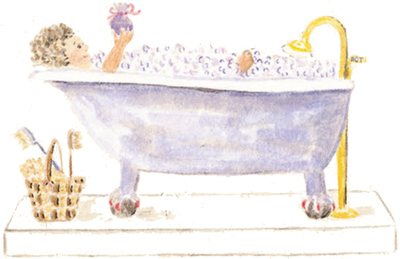

Aromatherapists and herbalists recommend the sweet, blended fragrances of herbs and flowers for calming, colorful dreams. Mix together dried lavender flowers, lemon balm leaves, and fennel and dill seeds.
Cut a 6-by-12-inch piece of soft fabric and fold it in half. Squeeze a narrow bead of fabric glue (found in craft and yard-goods stores) along two of the edges and allow the seams to dry. Loosely fill the pillow (it should be flat enough to slip inside a pillowcase) and finish closing the bag with another bead of glue.
Slip the thin, fragrant pillow inside your pillowcase and drift off to sleep on a cloud of herb-scented dreams.
